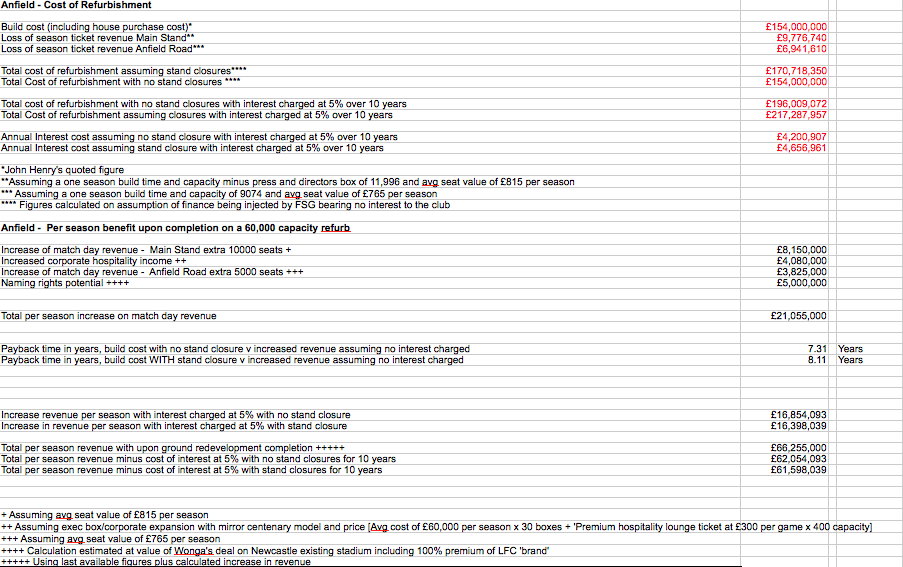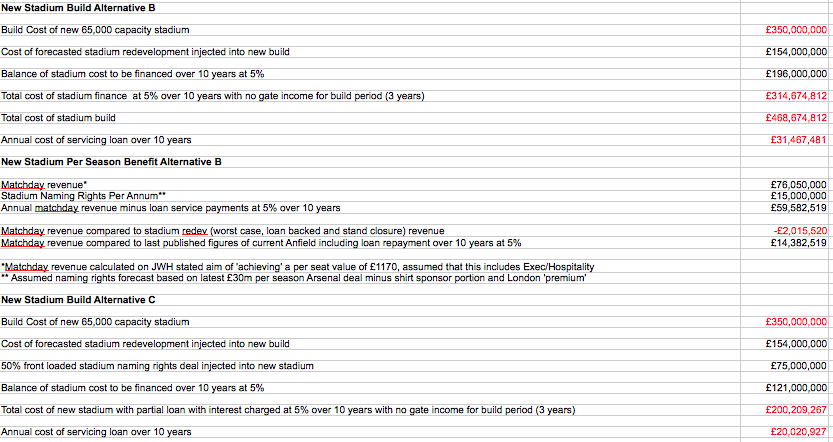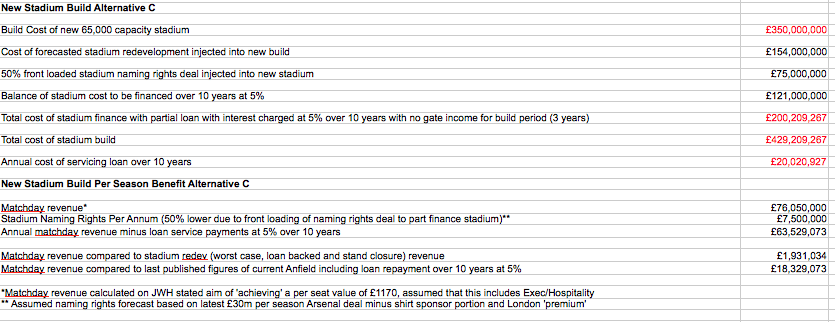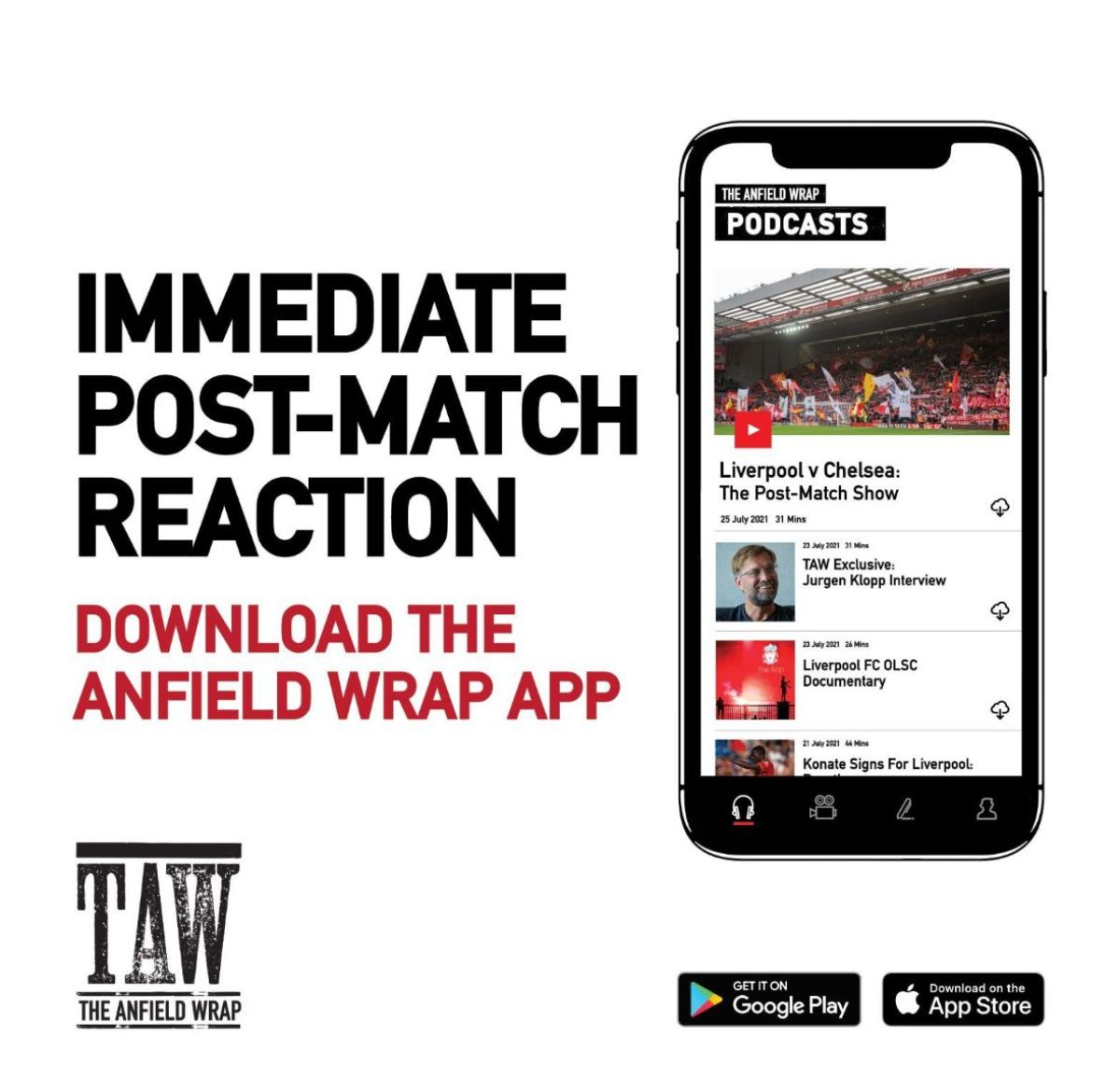*DISCLAIMER – I GOT A D IN GCSE MATHS AND TAKE NO RESPONSIBILITY WHATSOEVER FOR THE ACCURACY OF THE CALCULATIONS. SOZ.
**Serious for a second, any obvious mistakes, please let me know and i’ll happily correct them, but every effort has been taken to ensure accuracy.
NUMBERS? I FUCKING HATE THEM.
Stats, forecasts, percentages, bank statements (Especially bank statements), no, sorry not for me, far too deceptive, horrible little things, as the cliche goes, you can prove anything with stats and if my Auntie Joanne had bollocks she’d be my Uncle Joe, but she isn’t, but I bet you could grab some numbers to make it statistically probable.
With that out of the way, why have I spent the a fair portion of the morning bouncing numbers around a spreadsheet?
Well, mainly because i’m a bore, but also because I think its interesting to challenge perceived wisdom, especially when it comes to our much beloved togger and in particular Liverpool Football Club and Athletic Grounds Limited and its seemingly ever lasting grind towards a stadium solution.
I noted with curiosity quotes attributed to our Principal owner, Mr John W Henry, in regards to progress with Fenway Sports Group’s preferred option of ‘rebuilding’ Anfield having jettisoned any plans to build a new facility, written off and thrown on the scrapheap.
Henry, referring to the now abandoned plans of our former owners said: “They [Hicks and Gillett] were talking about going out and borrowing an enormous amount of money for an enormous facility. That’s not what we are doing here. One of their problems is that they weren’t able to get financing.”
Why Henry chose to speak out over the issue under seemingly little pressure to do so is his business, but having had a look at the numbers, Henry has a point, especially when it compared with the cost of redeveloping Anfield, but as with most things, scratch away a little bit and speak to people who have an idea what they are talking about and everything isn’t quite so black and white.
Having taken all the figures available and best guessing others using other examples, I had a little play around with some numbers and the results, to me at least, were interesting.
First off, I looked at the potential costs and benefits of redeveloping Anfield.
As the financing and actual plans for the redevelopment aren’t currently available, I included figures for a rebuild using both a financed build and an FSG funded build, both scenarios showing a healthy increase in per season match day revenue with seemingly very little risk, a no brainer, especially when compared to the cost of a totally financed new build, which I costed below, again, using cast iron figures when I could a researched estimates when I couldn’t.
Using the 3 year build period of The Emirates as a guide, you can see, even with a 65,000 capacity new facility the build costs are crippling with the club actually making over £12m less over the 10 year financing period that we are currently at Anfield mainly due to the crippling build period with no income to speak of, it is also very doubtful whether FSG would find a willing lender to finance the project 100%.
Whilst in the long run it’s clear that the benefits of a 65,000 new facility are far greater than a redevelopment, with more scope for corporate spend, greater impact and jobs in the local area, the chance to be the symbol andkey driver of a massive and long overdue regeneration of the local area, a chance for the club to build a football village with its own bars, restaurants and hotels and a more comfortable stadium for supporters which could be the pride of Europe, and most importantly, having the capacity to enfranchise the next generation of supporter with reduced tickets for kids and families long priced out of going the game.
But a simple glance at the figures show that such idealism is foolish and beyond our means.
Or is it?
What Henry failed to mention when he spoke of Hicks and Gillett was that massive borrowing to build wasn’t an absolute necessity, indeed, whilst it was Tom ‘Mr Leverage’ Hicks weapon of choice, having looked at Arsenal’s model for building the Emirates, whilst it may be a partial necessary evil, its not the absolute be all and end all.
One option open to FSG would be to redirect the £154m earmarked for the Anfield redevelopment and pour it into the new build, not only does this, on paper at least, take a massive slice out the cost of interest charged for building the facility, it brings the total cost of the stadium down by over £110m, saving over £26m a year in interest.
Despite this, and the obvious end benefit once finance is paid off of a match day revenue of over £76m as opposed to our last currently available published figure of £45.2 million, the new facility would, to the tune of over £2m, be less beneficial that the proposed redevelopment as detailed above regardless of the more beneficial long term benefits, it is also worth bearing in mind there is also no added income from any additional ‘outside’ revenues such as bars and leisure facilities included which, you would imagine, bridge the gap.
Another option, and one Arsenal used to their benefit, is to take advantage of a ‘front-loaded’ naming rights deal, where a naming rights partner would advance 50% of a 10 year naming rights deal into the club, reducing the need for finance even further, obviously finding a partner that is happy to front such an amount for a project that they won’t see open for 3 years presents its own challenges but, as Arsenal have proved, is not impossible.
By using such a mechanism, the money lost per annum through the front loading is saved on interest payments and also further reduces the risk to the club financially, brings the overall cost of the stadium down another £39m and and reduces annual interest by a further £11m to £20m as well as nudging past the forecasted income of a refurbished Anfield even during the loan bearing period.
The big question, assuming FSG have the facility to inject that kind of capital, is whether they are serious enough about their investment in Liverpool Football Club as a commitment on such a scale would be reflected in the value of the asset (ie the Club) once the stadium is built.
As ever, its easy to sit and hypothesise from the freedom of a couch of a Sunday afternoon without knowing the exact ins and outs of Fenway Sports Group, its ambitions and indeed the international money markets and it goes without saying that any move forward is welcome but their next move is this regard is likely to shape the club long after they are gone.
With this is mind, would it unreasonable to expect them to put all the options on the table and let the fans have a say as opposed to conveniently timed sound bites and glossy prospectuses pushing a refurbishment as the only solution?
Only then can we judge for ourselves whether the numbers add up.















Hi Andy,
Articles like these are why I love the Anfield Wrap. I’ve debated the issue with friends based on snippets of info from here and there. We needed an insightful review into what is a major step for LFC.
Only time will tell if we can balance the stadium development with closing the gap on the ‘big four’ through quality player acquisition. Fingers crossed they’ve done their sums and we can continue to build the squad and bring the stadium up to a top European standard.
That being said, as the guys said in the last podcast – were going to win the league any way.
Jim
Wow Andy,
What a waste of a Sunday!Couldn’t you have gone bird watching or fishing or something?
Don’t get me wrong I really do appreciate your obvious dedication to solving our plight and your efforts to put all these wrongs(?) right.
But here’s the thing;people like this don’t look at things like you.Sorry Mate but there’s a bigger picture and that’s why you are there and I am here.
Take a step back for a moment.Look at how many players we have out on loan all over the place.We’ve just signed them and now they are out on loan.Somebody else picks up their wages and we pick up a transfer fee if they come good.Does the idea of speculate to accumulate sound like a good investment? Just look at Parma in Italy.
So far as a new stadium is concerned why bother?It’s generally accepted that the days of corporate entertaining are on the wain.At the same time potential for streaming of live games is just the tip of the iceberg.
Think about live streaming to maybe 2 or 3 million subscribers in the far east at possibly £2 or £3 per head for every home game.Why would you need a new stadium?
Of course you need a reasonably successful team to pull this off and at the moment we’re doing O.K.
But things can change like the weather.And that’s why it makes little sense to invest in bricks and mortar at the moment.
But still and all a great piece of accounting and auditing.But unfortunately not one that would make much sense to FSG.
I really like this article. Good job Andy!
If we look at a new stadium, is there any chance that we can get revenue from Anfield to service the costs involved?
I thought the redevelopment was being done in such a way as to keep the main and anfield road stands open while the extensions were being build behind the existing stands? if this is the case then there wont be any lost revenue from those stands while the build is being completed.
Andy,
the £154m is still being loaned, from the club’s existing banking facilities (read RBS and co) according to some reports. You can’t make the leap you’re doing there sorry.
It’s loan £154m and pay for a redevelopment. Or loan the full amount for a new stadium. And as you’ve realised, loaning the full amount for a new stadium doesn’t add up.
All the best,
Zeb
And yeah, loaned should read borrowed. I’m drunk.
The thing is, the £154m that you talk about FSG ‘redirecting’ to spend on a new stadium would still be borrowed from somewhere, so there would still be interest costs associated with it. Presumably that’ll impact on your calculations.
Also, I think you’ve overestimated how much Arsenal receive for naming rights, and the impact ‘front loading’ has had on their finances. According to the Swiss Ramble they received £90m in combined stadium and short sponsorship. The stadium aspect was worth £42m for 15 years naming rights. The shirt sponsorship brought in £48m for 8 years. Compare that to how much we get from Standard Chartered.
I’m sure you’ve put a good case forward regarding the figures. Truth is, I didn’t even sit my maths exam and I’m not that good at understanding figures so it’s unintentional if I make my point whilst not paying heed to your calculations.
There is a bigger picture here, as you point out, for the long term future but I wouldn’t like to predict how football will be in 20 years time. I believe the future of football is going down the route of streaming. Even at a time when each LFC game means so much I’ll be selling my ticket for Saturday as I feel I could do with the £45. Sundays for me are taken with managing a kids football team and so Saturday I’m gonna relax a bit with the family and put the game on at 2.50. By 5 o clock I’ll be ready to do something else.
More importantly than my ramblings are the global implications. LFC is global. It touches every corner of the world and the percentage of fans who can make the game is tiny. At the minute, they’ll all be watching on dodgy streams. For the fans who can make it, how keen would they be once the ticket prices rise again? Both Arsenal and the Utd models for increased capacity suggest price hikes go hand in hand. Would LFC be able to sell the required corporate tickets week in week out for the next 20 years or so? Possibly but it’s not a certainty. Would people want to stay in hotels in Anfield or dine out there? Who knows!
My belief is, the most important thing for LFC is to try and get back into the CL and then consolidate that place. That’s even more important than the stadium. Maybe, they go hand in hand but looking at the decade Arsenal have had it doesn’t bode well. They’ve been helped by their transfers out too.
I appreciate this point is too personal to have any relevance but I’m gonna throw it in anyway. When I was in my teens I was addicted to going to Anfield. The adrenaline of being on the Kop as it surged forward and the camaraderie I felt as blokes formed a circular barricade to pick me up off the floor was, like I said, addictive.
My son is LFC obsessed. The times I take him to the match though are often a disappointment for me. He’s only been about 10 times but even now I feel he gets bored. I don’t think the ‘buzz’ of going to Anfield is that great for kids after the first few times. It’s a pretty sterile environment. It doesn’t have the ‘edge’ it used to for kids. So I do wonder how many kids would turn out regularly even if there were cheaper seats.
So, I feel the annual difference of income between a new build and renovating Anfield could be best gotten elsewhere. I’m not saying I wouldn’t like one (although I left Wembley 3 times a couple of seasons ago thinking how soulless it was due to the layout) but I share Henry’s view that a new stadium (or even renovation) is not a ‘magic wand’.
Finally, I absolutely respect SOS’s campaign to get ticket prices reduced but the reality is they’re indexed with players wages. I believe FSG are at the forefront of trying to fight back against these ridiculous wages, whether that’s for their own benefit rather than the good of football is irrelevant.
Andy,
Am I missing something here… you seem to be suggesting FSG magic up the 150m+ Anfield upgrade funds and stick it against the cost of building a new stadium?!
I haven’t seen anything to suggest FSG have this cash burning a hole in their pockets and can provide it interest free towards either an Anfield upgrade or new stadium. Rather, I think Henry is saying that the facilities to borrow the 150m+ are already in place.
A new stadium has it’s attractions but it doesn’t help the team in the short term, and even if a large naming rights contract was agreed we would see a negative impact on the abilities to compete for players in the short to medium term (see Arsenal).
Liverpool need a solution that provides extra revenue in the medium term, and does not impact the funds available for team development in the short term. Anfield expansion is the only way these twin aims will be achieved.
Graeme
Seems “in” has been auto corrected to “is” on end of article.
you all (fan website/fanzine editors) should do a simultaneous survey and scope the opinions and feel of the fans.
Probably not the right thing to say, but what’s the point of consulting with fans about whether they’d prefer a new build or a redevelopment when there’s only one option on the table?
As others have said, some of the key assumptions in this article are wrong. When corrected they (should) completely change the conclusion that a new build is just as viable as a redevelopment.
The last couple of paragraphs, based on dodgy figures, seem to suggest that FSG’s decision to renovate instead of build could be because they’re not committed to the club in the long term. Does that really help in any way?
I understand what you’re saying there so this isn’t a reply to you as such but i don’t understand where this ‘the owners are not committed to the club’ comes from. I might be wrong but I think it was Nick o Prey who said ‘the owners are not looking beyond 3 years as they won’t be here then, in regards to transfers, a couple of podcasts ago.
Gareth Roberts made a simple but excellent comment recently when he said ‘it’s all open to interpretation’ regarding the owners and that’s the truth of it. We simply don’t know their intentions and our opinions can only be based on instinct or gut feeling. Obviously, some people who have closer links to the club may know more than us average fans but I can only base my opinion on instinct or possibly intuition.
My view is that FSG bought Liverpool because they had a vision. Massive club!! Not exploiting it’s commercial potential!! Under performing on the pitch regarding where a club that big should be!! Going fairly cheap due to the mess it’s in!! Spewing money on wank players that can’t get in the first 11!! Laissez faire or incompetent previous owners since the PL formed. Jesus, it looked a gamble worth taking for anyone with half a brain. Obviously, they also felt that marketing the brand, with it being in the top 4 in the world, combined with FFP would give them the tools to compete on the pitch.
Then, equally important, would have been the potential to increase capacity, therefore turnover as well as the increased TV money (regardless of when that was actually announced) and the potential CL money. So, I think they saw the opportunity to build LFC back up simply by running them more as a modern day business. Exactly like Utd have been doing for 25 years.
They would have known about the Glazers. Bought Utd for around £800m of borrowed money and now valued by themselves (ahem) at £1.6b. Not being keen on waste they knew it would be better to pay up front rather than loan as it was only £300m.
So eventually, if things went according to plan, the club would be making a tidy profit, they’d be more successful on the pitch, the brand would be making a fortune and they’d have a 60k seater stadium, that was almost paid off, as an asset too. Surely, that would be worth more than £300m even based on Utd’s actual valuation. The figure could even be as high as £800m. What are the risks? Well, the only risk is you can’t predict sport. You can influence business and marketing though and balance the books and so they’d always make a profit, albeit smaller, even if they can’t bring success to the team. It’s a risk free venture.
That vision can’t be implemented over night though. I know you hear it’s a 3 – 5 year plan being bandied about but that’s almost certainly phase 1 – getting Liverpool competitive again. The next 5 years would be consolidating that whilst simultaneously the club pays off the loan to increase the stadium. Then in 10 years – see ya later. Payday. I’ve never been against that because it’s mutually beneficial and what LFC needs. Face it, if Abramovich or Sheikh Mansour leave their clubs they’ll be fucked. When FSG go we’ll be a well run club with stability and foundations.
Conscious of the fact I’m stoned and rambling on I’ll try and concisely say, if that is their vision then it’s not a 3 year plan. It’s not a 5 year plan. It’s 10-12 years. Buying 17 year olds when they’re cheap in the hope they’ll either make the squad or sell for more x years down the line is not a short term plan either. It all points to a longer time span.
I may be wrong and like i say, others may have heard things from people who are genuinely connected to the club but the above is how I see it and I can’t see much evidence to the contrary.
A couple of things:
Regenerating Anfield to 60,000 or 65000 doesn’t future proof us, and I think if we wanted to expand further, we’d struggle to do so at anfield. United have expanded their stadium several times, a few thousand each time, to over 75000 now. If we regenerate anfield, getting to 60000 or 65000 is fine, but the bigger we want to expand the harder and more expensive it gets in the long run, so we’d eventually have to build a whole new stadium to get to over 70000 which means long term, regenerating anfield is not the better option.
That said however, there is no guarantee that we would fill the stadium every week. Yes it is impossible to get tickets now, but with a bigger stadium we have no guarantee that the (and I’m one of them), the travelling supporters from London and/ or Europe would pay the 75 quid train ticket to watch the lower sides. United forced their season ticket holders to attend the league cup games and other games that their supporters didn’t care about, to ensure that the stadium was always filled and supporters bought prawn sandwiches / drinks etc, which also generates revenue.
Finally, when arsenal negotiated their deal for naming rights to be paid 3 years in advance, they were recently (2-3 years previous) champions and had been champions more than once in the preceding years. Its like when we negotiated the deal with standard chartered – we had been in 2 European cup finals and finished second in the league. Being successful increases a clubs bargaining power to get better sponsorship deals. Our current bargaining position is weakened by our recent league finishes, making us a much less attractive option for any sponsorship to rival the standard chartered deal, or the emirates naming deal.